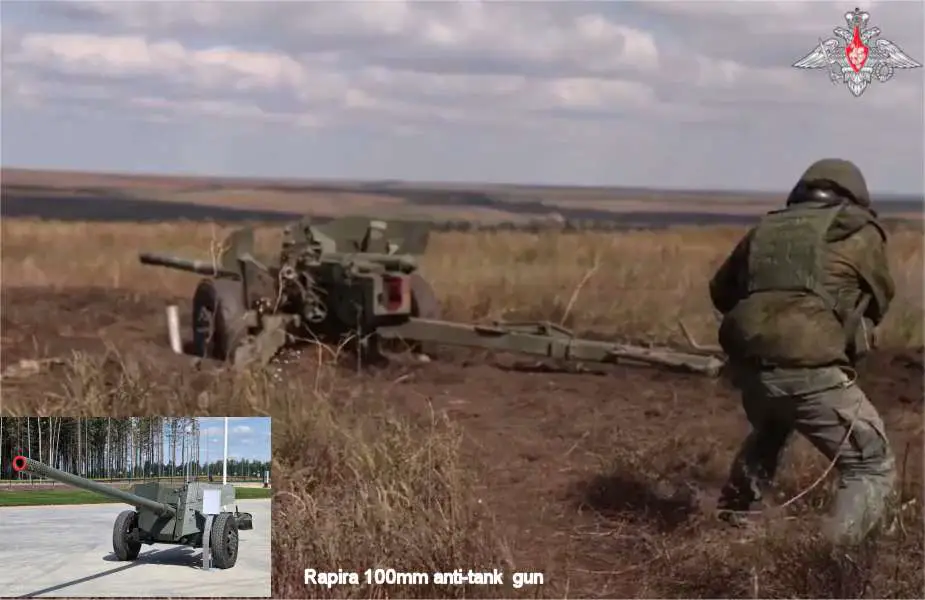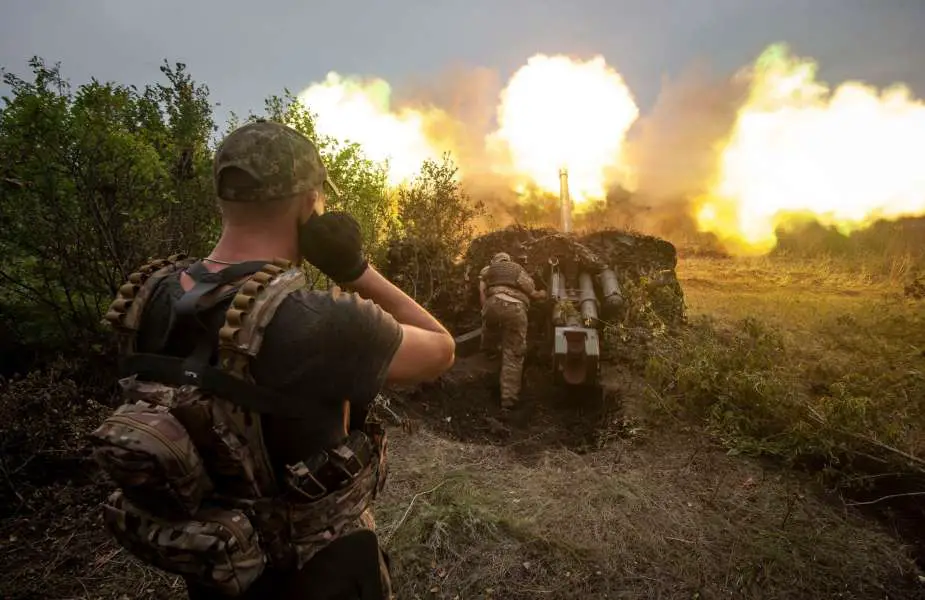A video released on December 19, 2023, on Russian official social media shows crews of the MT-12 Rapira, also known as 2A29, anti-tank guns from the Vostok group of forces fighting against Western armored vehicles in the South Donetsk direction of the Northern Military District. It is interesting to note that this anti-tank gun was developed in the 1960s.
Follow Army Recognition on Google News at this link

Soviet-era MT-12 Rapira 100mm towed anti-tank gun. (Picture source: Wikimedia and Russian MoD)
In the context of the conflict in Ukraine, Russia's use of the MT-12 Rapira also called 2A29, anti-tank gun in indirect fire and defensive positions reveals an adaptive strategy to the evolving combat conditions. The 100 mm T-12 anti-tank gun has the industrial designation 2A19, was accepted for service in 1961, and was followed by the improved MT-12 which has the industrial designation 2A29. The MT-12 anti-tank gun entered production in 1970. The 100 mm T-12/MT-12 was the first smoothbore anti-tank gun in the world to enter production.
The MT-12 Rapira, traditionally designed for direct fire against armored vehicles, also has the capability of conducting indirect fire. This functionality allows Russian forces to use it to bombard enemy positions at a distance, without requiring direct line of sight. In this mode of use, the MT-12 can serve as support artillery, complementing other weapon systems. It becomes a crucial tool in a strategy of wearing down the enemy, allowing for the attack of strategic points such as fortified positions or supply lines, while minimizing the exposure of the crew and equipment to enemy fire.
Indeed basically, the T-12/MT-12 is used, by the anti-tank units of armored and motorized rifle regiments, to protect open flanks against counterattacks during rapid advances.
As said above, the T-12/MT-12 has been designed for use in direct-fire mode, both weapons also have indirect fire sights. Their range in this role is, however, limited as maximum elevation is only +20º. For elevations above +15º, a pit has to be dug under and to the rear of the breech, or the breech will hit the ground during recoil.
From a defensive standpoint, the integration of the MT-12 into the Russian front lines appears to meet a crucial need to increase anti-tank capability both against Ukrainian armored advances and in established position warfare. In March 2023, a full train of these cannons was removed from storage and sent to the front, suggesting an attempt to reinforce available artillery. In a defensive position, the MT-12s are used to establish effective anti-tank zones, aiming to stop or slow down the offensive of enemy armored vehicles. Finally, this situation could also reflect a shortage of modern guided anti-tank systems (ATGMs), forcing Russia to rely on more traditional means despite their limitations in a modern war context.
Russia's use of the MT-12 Rapira in indirect fire and defensive positions thus illustrates a pragmatic approach, seeking to maximize the use of available resources while adapting to the specific challenges posed by the Ukrainian conflict. This demonstrates the need for a balance between traditional combat methods and adaptation to contemporary tactics and threats
The T-12/MT-12 is operated by a six-man crew consisting of the detachment commander, driver of the towing vehicle, gunlayer on the left, loader on the right, and two ammunition numbers.
The MT-12 Rapira anti-tank gun features a robust design, characterized by its 100 mm smoothbore barrel which measures 6.30 meters in length. The barrel's front portion is reinforced and equipped with a perforated muzzle brake, enhancing its durability and performance. In transit mode, the barrel is securely fastened to the gun's trails using a lug positioned on the breech ring, ensuring stability during movement.
Central to the MT-12's operation is its breech ring, housing the vertical breech block and integral components of the semi-automatic loading system. The breech block operation is initially manual, requiring the loader to open and close it. This manual intervention is necessary only for the initial round. Subsequently, the semi-automatic system, located to the right of the breech ring on the upper carriage, automates the opening and closing processes, allowing the loader to focus solely on reloading the gun.
The gun's carriage is designed as a split trail type, with a notable addition of a castor wheel on the left trail. This feature is instrumental in swiftly mobilizing the weapon into combat positions. A compact shield, with rear-sloping sides, is also part of the carriage design, offering partial protection to the crew against small arms fire and shrapnel.
A key distinction between the MT-12 and its predecessor, the T-12, lies in the carriage design. The T-12 was typically towed by trucks, whereas the MT-12 is towed using the MT-LB, a tracked armored vehicle. This enhancement in the carriage design not only improves mobility but also aligns the MT-12 with modern military logistics and deployment strategies.
The MT-12 Rapira anti-tank gun is equipped with a range of ammunition types, each designed for specific combat scenarios. The APFSDS (Armor-Piercing Fin-Stabilized Discarding Sabot) rounds have a muzzle velocity of 1,575 meters per second and are effective up to a direct fire range of 3,000 meters. Weighing 19.34 kg, these rounds can penetrate 230 mm of rolled homogeneous armor (RHA) at a distance of 500 meters, decreasing to 140 mm at 3,000 meters. The HEAT (High-Explosive Anti-Tank) rounds, traveling at 975 meters per second, have a direct fire range of 5,955 meters and a consistent penetration capability of 350 mm of RHA at 90º. These rounds are heavier, weighing 23.00 kg. Additionally, the HE (High-Explosive) rounds, designed for indirect fire, have a muzzle velocity of 700 meters per second and can reach targets up to 8,200 meters away, with each round weighing 18.6 kg.
Moreover, the T-12/MT-12 can fire the 9M117 Kastet (Knuckleduster) laser-guided projectile, which NATO designated as Stabber. This projectile has a range between 100 and 4,000 meters, and its HEAT warhead can penetrate between 550 and 600 mm of conventional steel armor. The laser designator, typically mounted on a tripod to the left of the weapon, aids in target acquisition. The original version of the 9M117 missile featured a single HEAT warhead, but a more recent version includes a tandem HEAT warhead capable of penetrating 550 mm of rolled homogeneous armor protected by explosive reactive armor. While this laser-guided projectile variant has been offered on the export market, there have been no known sales as of late 2003.

Soviet-era MT-12 Rapira 100mm towed anti-tank gun. (Picture source: Russian Social Media)















